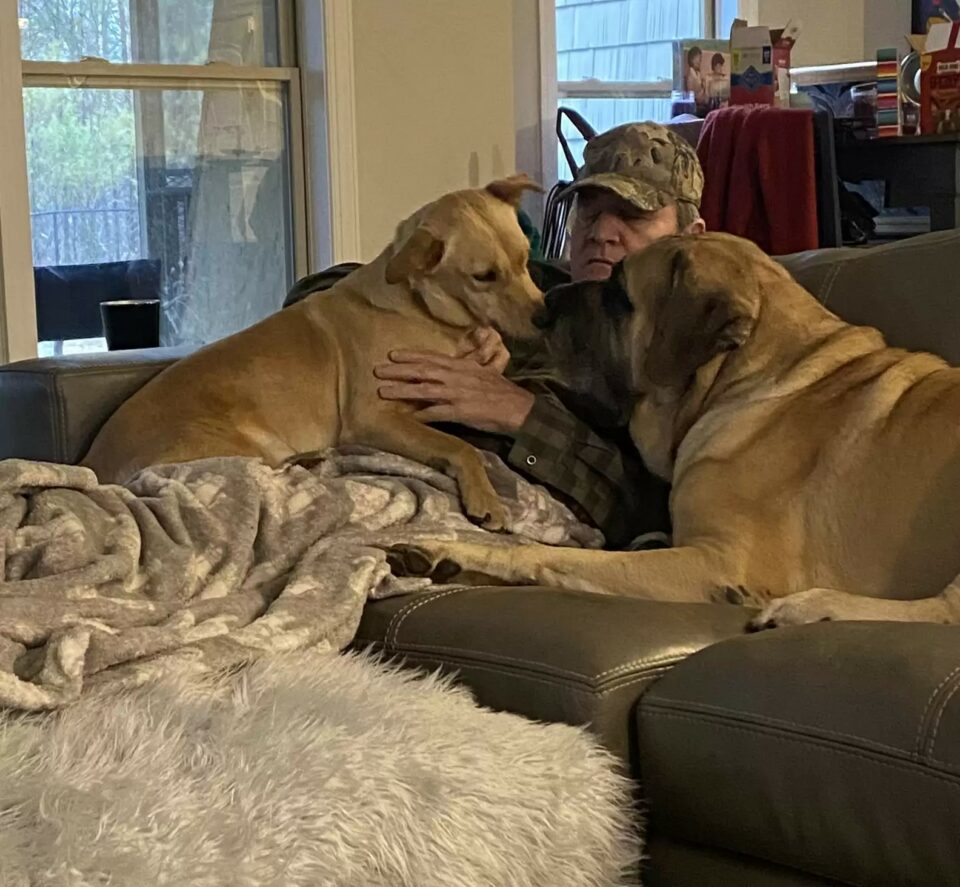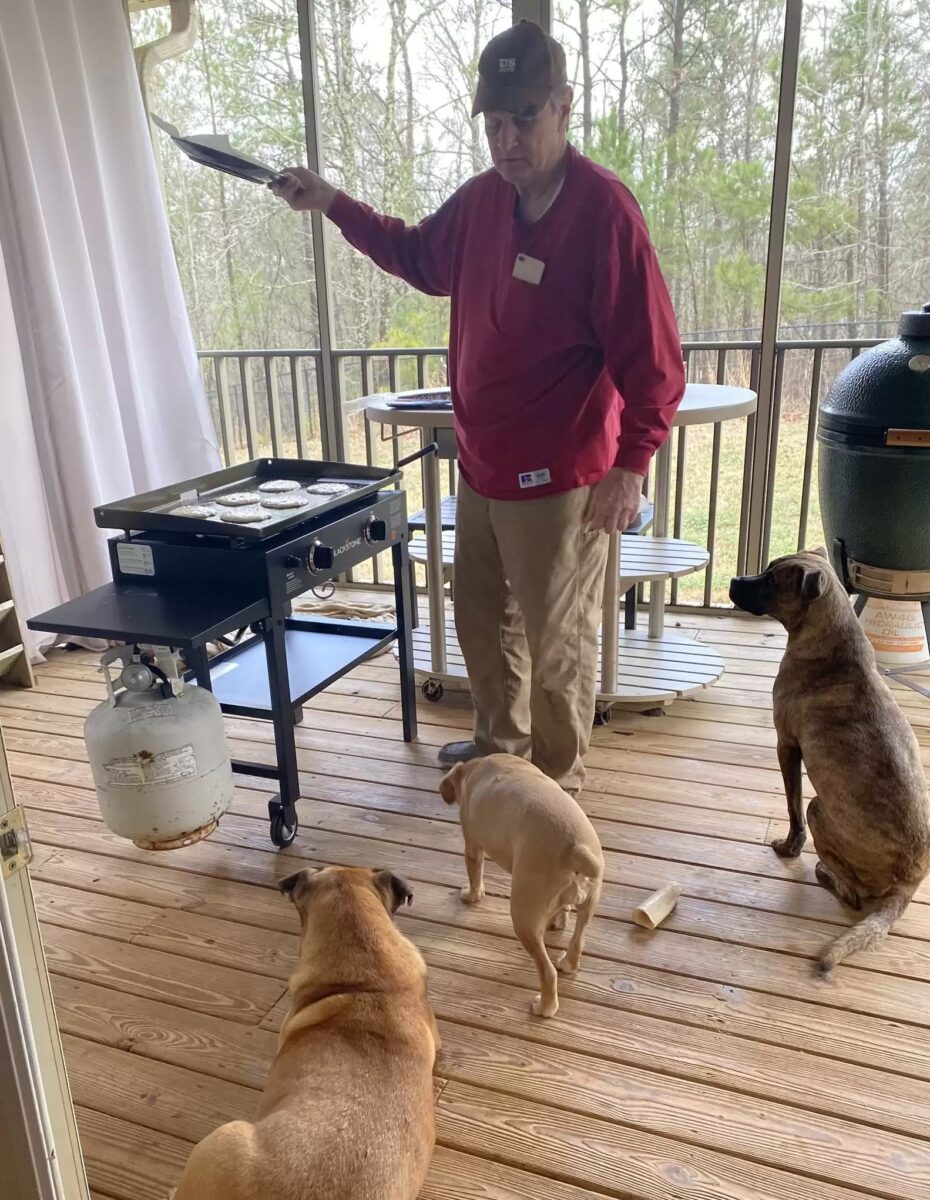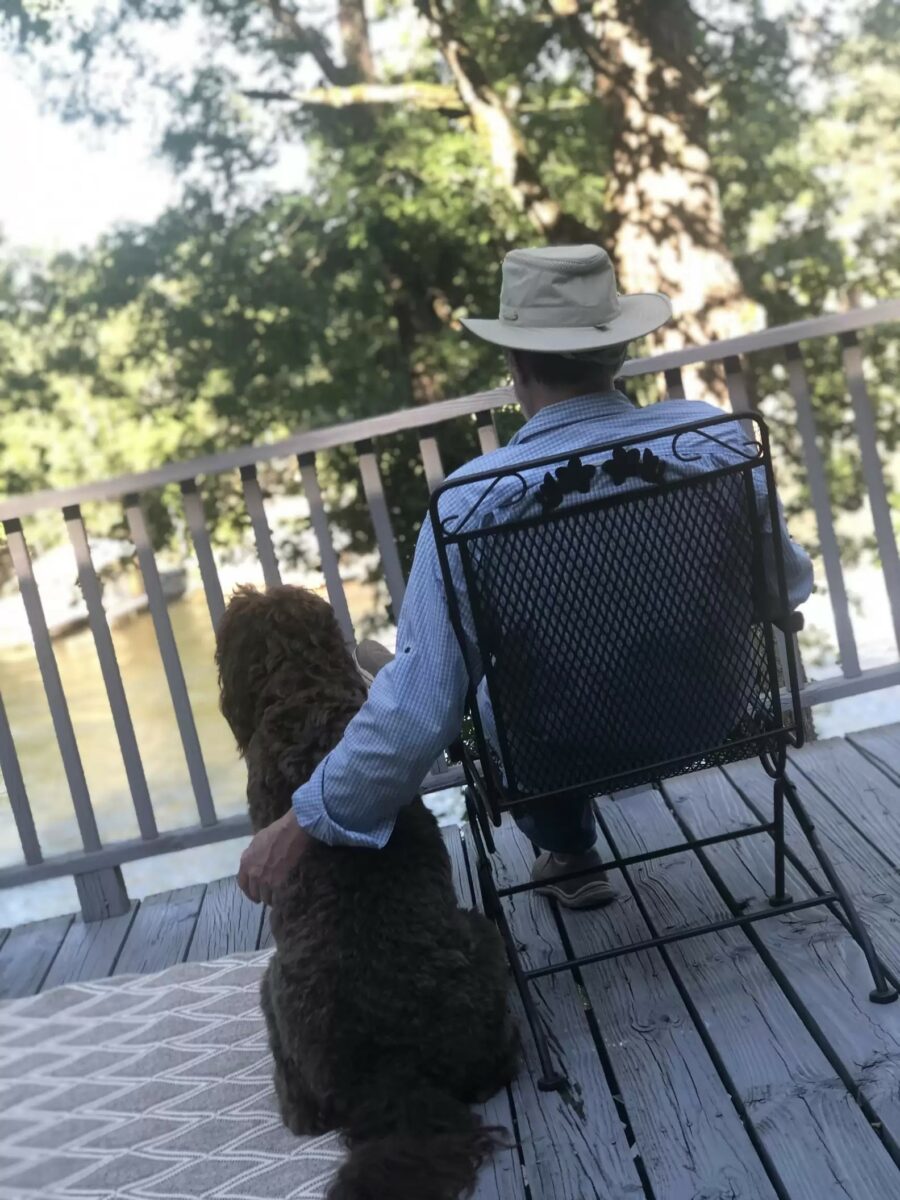So many times, we hear stories about cruel people who abuse or neglect their canines for various reasons. Those are the facts that break the hearts of true dog lovers.
Fortunately, there are always kind souls who restore hope in the true love between a man and his best furry friend. The main character of today’s story is the best proof of that.
This great man has always been a magnet for dogs, but his relationship with them in his later years truly melts hearts.
A Special Connection

Catey Hall already knows that her dad, Lon, loves canines. However, what truly brings tears of joy to her eyes is seeing him napping with them on the couch. According to her, he never sleeps alone, but with a few neighbour pups who visit him regularly.
“Dad sees, plays with and naps with one or more of these dogs on a daily basis,” Hall told The Dodo. “They come running when they see his car and follow him inside.”
Rosie, Fluffer-Nutter, and Hooch are all the dogs from the neighbourhood, and they are over the moon when they have the opportunity to be with him. It is truly a special connection between this human and the neighbour’s canines, and they are like one big family.

“The neighbourhood is an unincorporated section of semi-rural Alabama. The houses are set far back from the street, so the dogs can bounce from house to house safely,” Hall said. “The dogs can usually hear my dad’s truck coming, and they will meet him in the driveway.”
The very neighbours who own them do not protest because their dogs spend more time with Lon than with them. Even more, they themselves enjoy seeing them happy together.
It is the best proof of how much kindness this man actually has in his heart.
A Magnet For Canines

What makes Hall’s dad truly special is the fact that the doors of his home are always open for all the dogs, no matter if someone owns them or not. In fact, strays have always had a special place in his heart.
“For as long as I can remember, my dad has rescued stray dogs,” Hall said. “Growing up, we always had a dog. But there was always room for a stray in need.”
This man also shows love for canines through his activities in the Pound on the Hill, a local rescue in Bessemer, Alabama. Many dogs who didn’t have a home would immediately fall in love with him, and he wouldn’t have the heart to leave them. So, many have stayed with him forever.

Finally, even his daughter’s two dogs have a hard time resisting Lon. “As a matter of fact, they try to leave with Dad when he’s here visiting,” Hall said with a big smile on her face.
Lon is truly one of a kind – a walking magnet for canines.
If your furry companion is in discomfort, knowing how to alleviate their pain is crucial. Finding the right way to help your dog feel better can be a challenge, but as a seasoned dog trainer, you’re well aware of the importance of addressing their pain promptly. Understanding what options are available to provide relief for your canine friend is essential for their well-being. In this article, we’ll discuss various methods and treatments that can help manage your dog’s pain effectively.
As someone who deeply cares for their four-legged friend, you want to ensure they are comfortable and happy. Whether it’s due to aging, injury, or a medical condition, seeing your dog in pain can be distressing. By learning about the different ways to address your dog’s discomfort, you can make informed decisions to improve their quality of life. Stay tuned as we explore safe and effective ways to help ease your dog’s pain.
Understanding Canine Pain
When it comes to understanding canine pain, it’s crucial to recognize that dogs experience pain just like we do. They may not be able to communicate their discomfort verbally, but they exhibit signs of pain through changes in behavior, appetite, and overall demeanor.
Dogs can experience pain due to various reasons such as aging, injuries, arthritis, dental issues, or underlying medical conditions. It’s essential to pay attention to your dog’s behavior and any signs that may indicate they are in pain.
Common signs of pain in dogs include limping, reluctance to move or exercise, changes in eating habits, irritability, restlessness, and excessive licking or chewing on a specific area. Recognizing these signs can help you identify when your dog is in discomfort.
If you suspect your dog is in pain, it’s crucial to consult with a veterinarian to determine the cause and severity of the pain. Your vet may recommend pain management options such as medication, physical therapy, acupuncture, or other treatments tailored to your dog’s specific needs.
Understanding your dog’s pain and addressing it promptly can significantly improve their quality of life and overall well-being. By being proactive and observant, you can ensure that your furry companion receives the care and support they need to live a comfortable and pain-free life.
Medications for Pain Relief
When it comes to alleviating your furry companion’s pain, medications are often used to provide relief. Here are some common types of medications prescribed by veterinarians for pain management in dogs:
1. Nonsteroidal Anti-Inflammatory Drugs (NSAIDs)
NSAIDs are commonly used to reduce inflammation and control pain in dogs. They work by inhibiting enzymes that cause pain and inflammation. Examples include carprofen, meloxicam, and deracoxib. These medications are effective for various conditions, but proper dosage and monitoring are crucial to prevent side effects.
2. Opioids
Opioids are another category of medications used for pain relief in dogs, especially for severe pain or post-operative care. Tramadol and codeine are commonly prescribed opioids. These medications work by altering pain perception in the brain. Opioids should only be used under veterinary supervision due to their potential for side effects and dependency.
3. Steroids
Steroids like prednisone are sometimes prescribed to reduce inflammation and pain in dogs with certain conditions like arthritis or immune-mediated diseases. However, long-term use of steroids can have side effects, so it’s essential to follow your vet’s recommendations closely.
4. Gabapentin
Gabapentin is a medication commonly used to manage nerve pain in dogs. It can be beneficial for conditions like neuropathic pain or chronic pain syndromes. Gabapentin should be administered as directed by your veterinarian to ensure its effectiveness.
5. Topical Medications
Topical medications like lidocaine patches or gels can provide localized pain relief for dogs with skin conditions or post-surgical pain. These formulations are applied directly to the skin in the affected area and can be a useful addition to oral medications.
Remember, always consult your veterinarian before giving your dog any medication for pain relief to ensure the proper diagnosis and treatment plan. Proper administration and monitoring are crucial to your dog’s well-being and comfort.
Natural Remedies for Dog Pain
When looking for natural remedies to help alleviate your dog’s pain, consider these options:
1. Turmeric
Turmeric is known for its anti-inflammatory properties, which can help reduce pain in dogs with conditions like arthritis. You can add a small amount to your dog’s food or consult your vet for proper dosages.
2. CBD Oil
CBD oil has gained popularity for its pain-relieving effects in dogs. It can help manage chronic pain, inflammation, and anxiety. Ensure you use a high-quality product specifically designed for pets.
3. Omega-3 Fatty Acids
Adding Omega-3 fatty acids to your dog’s diet can help reduce inflammation and joint pain. Fish oil supplements or foods rich in Omega-3s can be beneficial.
4. Acupuncture
Acupuncture is a traditional Chinese medicine practice that can help alleviate pain in dogs. It involves inserting thin needles into specific points on the body to promote healing and pain relief.
5. Massage Therapy
Gentle massage can help relax muscles, improve circulation, and reduce pain in dogs. It’s essential to use gentle pressure and techniques to avoid causing discomfort to your furry friend.
6. Physical Therapy
Physical therapy exercises tailored to your dog’s needs can help improve mobility, alleviate pain, and prevent further injuries. Consult a veterinary professional or a canine physical therapist for guidance.
These natural remedies, when used correctly and in conjunction with veterinary advice, can provide relief for your dog’s pain and improve their overall quality of life. Remember to always consult your vet before starting any new treatment regimen.
Lifestyle Modifications to Help Alleviate Pain
When it comes to helping your furry friend deal with pain, there are several lifestyle modifications you can make that may alleviate their discomfort. Here are some practical tips to consider:
Regular Exercise
Ensuring your dog gets regular, gentle exercise can help alleviate pain by keeping their muscles and joints moving. Activities like short walks or gentle play sessions can be beneficial for your dog’s overall well-being.
Weight Management
Maintaining a healthy weight is crucial for managing pain in dogs, especially for those with joint issues. Consult your vet to determine the ideal weight for your dog and follow a balanced diet to help them stay within the recommended range.
Comfortable Sleeping Environment
Creating a cozy and supportive sleeping area for your dog can help reduce their pain. Provide a comfortable bed with adequate cushioning and support to alleviate pressure on their joints while they rest.
Temperature Control
Extreme temperatures can exacerbate pain in dogs, particularly those with arthritis or other joint issues. Ensure your home is kept at a comfortable temperature, and consider using heating pads or cooling mats to help soothe your dog’s discomfort.
Mental Stimulation
Engaging your dog in mentally stimulating activities can help distract them from their pain and improve their overall mood. Interactive toys, puzzle feeders, and training exercises can provide mental enrichment and reduce stress.
By implementing these lifestyle modifications and combining them with proper veterinary care, you can help alleviate your dog’s pain and improve their quality of life. Remember, always consult your vet before making any significant changes to your dog’s routine.
Conclusion
Now that you’re aware of the signs of pain in dogs and the various treatment options available, you can take proactive steps to ensure your furry friend’s well-being. Remember, early detection and intervention are key to managing your dog’s discomfort. Whether it’s through medication, natural remedies, or lifestyle adjustments, there are plenty of ways to help alleviate your dog’s pain. By working closely with your vet and incorporating these strategies into your dog’s routine, you can make a real difference in their quality of life. Stay attentive to your dog’s needs, provide a loving environment, and always seek professional advice when in doubt. Your dog’s health and happiness are worth the effort.
Frequently Asked Questions
What are common signs that my dog may be in pain?
Common signs of pain in dogs include limping, changes in behavior, decreased activity, yelping, excessive licking or biting, panting, restlessness, and changes in appetite or drinking habits.
Why is it important to consult a vet for canine pain?
Veterinary consultation is crucial to accurately diagnose the underlying cause of pain in dogs. A vet can recommend appropriate treatment, including medications, physical therapy, and natural remedies, to alleviate pain effectively.
What are some natural remedies to help alleviate pain in dogs?
Natural remedies such as turmeric, CBD oil, Omega-3 fatty acids, acupuncture, massage therapy, and physical therapy can be beneficial in managing pain and improving the overall well-being of dogs.
How can lifestyle modifications help in reducing pain in dogs?
Lifestyle modifications such as regular exercise, weight management, creating a comfortable sleeping environment, temperature control, and mental stimulation can contribute to alleviating pain in dogs and enhancing their quality of life.
[no_toc]

Hey there, I’m Janet Brooks, a dog-loving student from California. I’m all about helping pups in need, especially those without homes. Me and my awesome friends work together to give shelter and love to stray dogs. Oh, and I also write blogs about dogs to share helpful info.